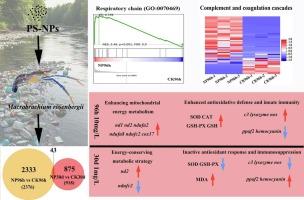Comparative analysis of acute and chronic toxicological exposure effects of polystyrene nanoparticles on Macrobrachium rosenbergii: Implications for antioxidative defense and immunosuppression
IF 2.2
2区 生物学
Q4 BIOCHEMISTRY & MOLECULAR BIOLOGY
Comparative Biochemistry and Physiology D-Genomics & Proteomics
Pub Date : 2025-08-19
DOI:10.1016/j.cbd.2025.101612
引用次数: 0
Abstract
Global pollution by microplastics (MPs) and nano-plastics (NPs) disrupts aquatic ecosystems and compromises the health of aquatic animals. However, there is a significant gap in the literature regarding acute high-dose and chronic low-dose polystyrene nano-plastic (PS-NP) exposures that simulate point-source and non-point source pollution events, respectively. The PS-NP concentrations (10 mg/L for acute exposure and 1 mg/L for chronic exposure) were designed to simulate realistic environmental scenarios. In this study, the giant freshwater prawn (Macrobrachium rosenbergii) was used as a model to investigate the differences on physiological functions under acute (96 h, 10 mg/L) and chronic (30 days, 1 mg/L) PS-NP exposure. Transcriptome sequencing and basic biochemical detection were utilized to analyze changes in gene expression, antioxidative and immunological responses of hepatopancreas. The results demonstrated that acute exposure to PS-NPs induced a significant upregulation of antioxidative and pro-inflammatory enzymes, suggesting a rapid stress response and activation of immediate defense mechanisms. In contrast, chronic exposure led to downregulation of mitochondrial and immune pathways, collapse of antioxidative defense, increased lipid peroxidation, and signs of immunosuppression. These findings underscored the time-dependent toxico-dynamics of PS-NPs and highlighted their potential ecological risks under prolonged exposure. The study provided molecular-level evidence to support more accurate environmental risk assessments and informs mitigation strategies for safeguarding aquaculture health in contaminated freshwater ecosystems.

聚苯乙烯纳米颗粒对罗氏沼虾急性和慢性毒理学暴露效应的比较分析:对抗氧化防御和免疫抑制的影响
微塑料(MPs)和纳米塑料(NPs)造成的全球污染破坏了水生生态系统,危及水生动物的健康。然而,关于急性高剂量和慢性低剂量聚苯乙烯纳米塑料(PS-NP)暴露分别模拟点源和非点源污染事件的文献存在显著空白。PS-NP浓度(急性暴露为10 mg/L,慢性暴露为1 mg/L)被设计为模拟现实环境情景。本研究以罗氏沼虾(Macrobrachium rosenbergii)为实验对象,研究急性(96 h, 10 mg/L)和慢性(30 d, 1 mg/L) PS-NP暴露对虾生理功能的影响。利用转录组测序和基础生化检测分析肝胰腺基因表达、抗氧化和免疫反应的变化。结果表明,急性暴露于PS-NPs诱导抗氧化和促炎酶显著上调,提示快速应激反应和即时防御机制的激活。相反,慢性暴露导致线粒体和免疫途径下调,抗氧化防御崩溃,脂质过氧化增加,免疫抑制迹象。这些发现强调了PS-NPs的时间依赖性毒性动力学,并强调了它们在长时间暴露下的潜在生态风险。该研究提供了分子水平的证据,以支持更准确的环境风险评估,并为保护受污染淡水生态系统中水产养殖健康的缓解战略提供信息。
本文章由计算机程序翻译,如有差异,请以英文原文为准。
求助全文
约1分钟内获得全文
求助全文
来源期刊
CiteScore
5.10
自引率
3.30%
发文量
69
审稿时长
33 days
期刊介绍:
Comparative Biochemistry & Physiology (CBP) publishes papers in comparative, environmental and evolutionary physiology.
Part D: Genomics and Proteomics (CBPD), focuses on “omics” approaches to physiology, including comparative and functional genomics, metagenomics, transcriptomics, proteomics, metabolomics, and lipidomics. Most studies employ “omics” and/or system biology to test specific hypotheses about molecular and biochemical mechanisms underlying physiological responses to the environment. We encourage papers that address fundamental questions in comparative physiology and biochemistry rather than studies with a focus that is purely technical, methodological or descriptive in nature.

 求助内容:
求助内容: 应助结果提醒方式:
应助结果提醒方式:


